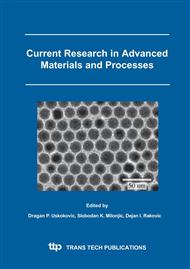p.315
p.321
p.327
p.333
p.339
p.345
p.351
p.357
p.363
The Influence of Acid Treatment on the Nanostructure and Textural Properties of Bentonite Clays
Abstract:
The nanostructure and textural properties of acid-activated bentonite clays from the Bogovina coalmine were investigated. The acid activation was performed with HCl in the concentration range 1.5-7.5 M. The atomic force microscopy followed by image analysis was used in order to establish the influence of the acid treatment on the size of bentonite particles. Nitrogen adsorption-desorption isotherms at -196 °C were used to estimate the specific surface area, pore volume and pore size distribution. The acid treatment reduces the size of bentonite particles and increases the specific surface area and pore volume of the investigated bentonites. These effects are improved by increasing the acid concentration up to 4.5 M HCl. Further increase in acid concentration does not result in development of new porous structure.
Info:
Periodical:
Pages:
339-344
Citation:
Online since:
September 2005
Authors:
Keywords:
Price:
Сopyright:
© 2005 Trans Tech Publications Ltd. All Rights Reserved
Share:
Citation:


